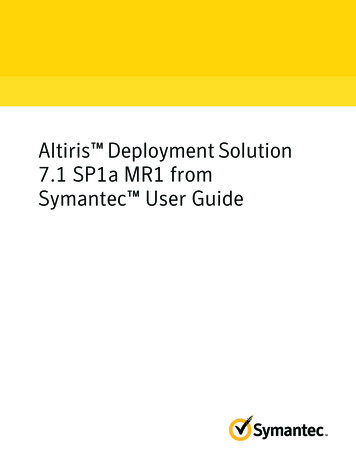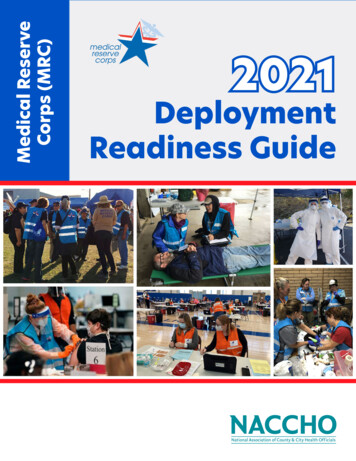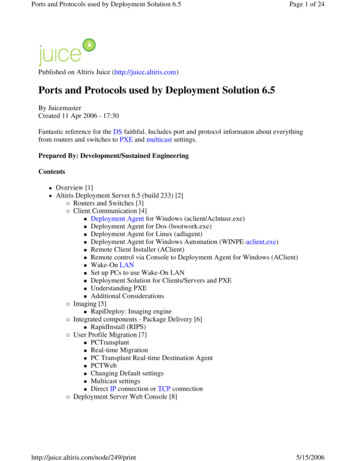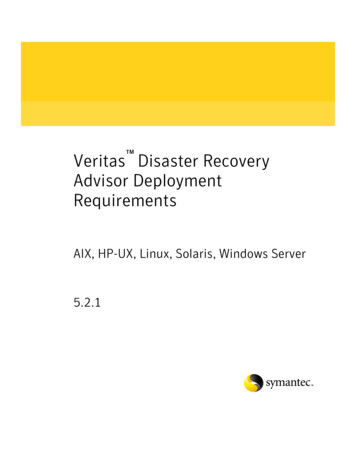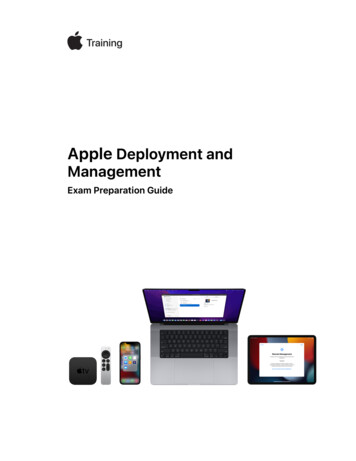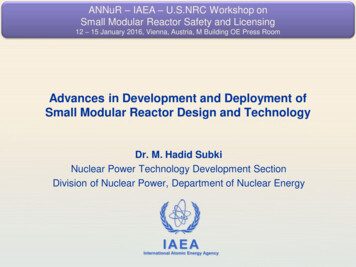
Transcription
ANNuR – IAEA – U.S.NRC Workshop onSmall Modular Reactor Safety and Licensing12 – 15 January 2016, Vienna, Austria, M Building OE Press RoomAdvances in Development and Deployment ofSmall Modular Reactor Design and TechnologyDr. M. Hadid SubkiNuclear Power Technology Development SectionDivision of Nuclear Power, Department of Nuclear EnergyIAEAInternational Atomic Energy Agency
OutlineMotivation, driving forces, & definitionSMRs for immediate & near term deploymentSMR estimated time of deploymentSMR design characteristicsPerceived advantages and potential challengesKey Member States activity in SMR design developmentElements to Facilitate SMR y/
Part IIntroduction to SMR Design andTechnology DevelopmentIAEA
SMRs are not new for IAEA Member States1958 – 1962:1963 – 1971: 1985:Small: Power 100 MWeMedium: Power 150 MWeSmall: Power 100 MWeMedium: Power 500 MWeSmall: Power 100 MWeMedium: Power 500 MWeIAEADesignation of the power-range changes over the decades
SMRs are not new for IAEA Member States1989 – 1995:Small: Power 300 MWeMedium: 300 P 700 MWeIncluding: AP600, SBWR,CANDU3 and CANDU6IAEA1996 – 2012: Small: Power 300 MWe Medium: 300 P 700 MWe Started R&D for Advancedmodular reactors Floating Nuclear Power Plants2012 – 2017: Small: Power 300 MWe Medium: 300 P 700 MWe Modular reactor – trend of development HTGR SMR under construction in China iPWR SMR under construction inArgentina Some certified, many under licensing
Past Activities Relevant to SMR Regulatory IssuesNo.Technical Meetings (TM)Place, Dates1The 6th INPRO Dialogue Forum on Global NuclearEnergy Sustainability: Licensing and Safety Issues for SMRs IAEA, Vienna, Austria29 July – 2 Aug 20132TM on Environmental Impact Assessment for theDeployment of SMRs IAEA, Vienna, Austria28 – 31 October 20133TC Interregional Workshop on Design, Technology andDeployment Considerations for SMRs IAEA, Vienna, Austria2 – 5 June 2014Publications: Booklets, Technical Reports, Nuclear Energy Series, TECDOCsIAEAIn-House Collaboration Enhances Productivity and Qualityin Serving the Member States6
Motivation – Driving Forces Advanced Reactors that produce electric power up to 300 MW, built infactories and transported as modules to utilities and sitesfor installation as demand arises.The need for flexible power generation for wider range ofusers and applicationsReplacement of aging fossil-fired unitsCogeneration needs in remote and off-grid areasPotential for enhanced safety margin through inherent and/orpassive safety featuresEconomic consideration – better affordabilityPotential for innovative energy systems: Cogeneration & non-electric applicationsHybrid energy systems of nuclear with renewablesIAEA7
SMR Technology DevelopmentStarCore LYIRISINDIAPFBR-500AHWR-300PHWRsSOUTH ACP-100CEFR
SMRs for immediate & near term deploymentSamples for land-based SMRsWater cooled SMRsIAEAGas cooled SMRs Liquid metal cooled SMRsLand-based, marine-based, and factory fuelled transportable SMRsEstimated power limit to be modular/transportable 180 MW(e)
11 IAEA Member States with SMRsCAREM2527PFBR500500KLT-40S35 x 2NuScale50 x 12AHWR300300RITM-20050mPower180 x PRISM311BREST300EM2240SVBR100GT-MHR285(2) ChinaCEFR20HTR-PM211ACP100100CAP150CAP-F(3) FranceFlexblue(6) ItalyIRIS165325(7) Japan150200(t)4S30(experimental)10MW(th)IAEA(10) South 0100(4) GermanyIHTR-10(11) United States(9) Russia(5) India(1) Argentina(8) South KoreaSMART100
SMRs Under Construction for ImmediatePage 11 of 37Deployment – the front runners CountryReactorModelOutput(MWe)DesignerNumberof 0RITM-200(Icebreaker)50IAEACommercialStartNear the Atucha-2 site2017 20182 mods,1 turbineShidaowan unit-12017 2018OKBMAfrikantov2modulesAkademik Lomonosov units 1 & 22016 2017OKBMAfrikantov2modulesRITM-200 nuclear-propelledicebreaker ship2017 2018HTR-PMCAREM-25Site, Plant ID,and unit #KLT-40S
SMRs under development for Near-term DeploymentPage 12 of 37- Some samples NameDesignOrganizationCountry ofOriginElectricalCapacity,MWe1System IntegratedModular AdvancedReactor (SMART)Korea Atomic EnergyResearch InstituteRepublic of Korea1002mPowerB&WGeneration mPower180/module3NuScaleNuScale Power Inc.United States ofAmericaUnited States sign StatusStandard Design Approval50/module(gross)Received 4 July 2012Preparing for DesignCertification ApplicationPreparing for DesignCertification ApplicationDetailed Design,Construction Starts in 2016NuScaleACP100
SMRs “Estimated” Timeline of DeploymentIAEA
SMR Design Characteristics (1): eneratorscore vesselSteamgeneratorsCRDMpumpscore vesselIAEA14
Page 15 of 37SMR Design Characteristics (2) Multi modules configuration Two or more modules located in one location/reactor building andcontrolled by single control room reduced staff new approach for I&C systemIAEA
SMR Design Characteristics (3) Modularization (construction technology) Factory manufactured, tested and Q.A.Heavy truck, rail, and barge shippingFaster constructionIncremental increase of capacity addition as neededIAEA
SMR Design Characteristics (Summary)Main FeaturesExpected AdvantageIntegratedReactor Coolant SystemSimplified, compact andless weightSafer,Flexible andEfficientOperationMulti Modules &Modular ConstructionEnhanced SafetyPerformancePassive EngineeredSafety FeaturesEnhanced MaintainabilityAdvancedInstrumentations & ControlsBetter Radiation ControlIncreasedSafety andReliabilityBetter costaffordabilityLonger Fuel CycleIAEAExtended Design Life
SMR Site Specific Considerations Site size requirements, boundary conditions, population,neighbours and environs Site structure plan; single or multi-unit site requirements What site specific issues could affect the sitepreparation schedule and costs? What is the footprint of the major facilities onthe site?IAEA
Perceived Advantages & Potential ChallengesTechnology IssuesChallenges Shorter construction period(modularization) Potential for enhanced safety andreliability Design simplicity Suitability for non-electricapplication (desalination, etc.). Replacement for aging fossilplants, reducing GHG emissions Licensability (first-of-a-kindstructure, systems and components) Non-LWR technologies Operability and Maintainability Staffing for multi-module plant;Human factor engineering; Post Fukushima action items ondesign, safety and licensing Advanced R&D needsNon-Techno IssuesAdvantages Fitness for smaller electricity grids Options to match demand growthby incremental capacity increase Site flexibility Smaller footprint Reduced emergency planning zone Lower upfront capital cost (betteraffordability) Easier financing scheme IAEAEconomic competitivenessPlant cost estimateRegulatory infrastructureAvailability of design for newcomersPost Fukushima action items oninstitutional issues and publicacceptance
Key Design Characteristics ofAdvanced Passive Water-Cooled ReactorsPage 20 of 371Independent of AC Power Require no AC power to actuate/operate Engineered SafetyFeatures; Only gravity flow, condensationnatural circulation forces neededto safely cool the reactor core Passively safe shutdown thereactor, cools the core, andremoves decay heat out ofcontainment3 Design simplification2Less reliance on operator actionProvides 3 to more than 7 days of reactor coolingwithout AC power or operator action4Incorporating lessons-learned from theFukushima Dai-ichi nuclear accident Enhanced robustness to extreme external eventsby addressing potential vulnerabilities Alternate AC independent water additions inAccident Management – SBO mitigation Ambient air as alternate Ultimate Heat Sink Filtered containment venting Diversity in Emergency Core Cooling SystemFewer number of plant systemsand componentsReducing plant construction andO&M costsIAEA20Images Courtesy of Westinghouse and GE Nuclear Energy
Page 21 of 37Incorporating Lessons Learned from Major Accidents toAdvanced Reactor and SMR DevelopmentsResilience towards Extreme external events (regions and sites specific) Assure safety on multiple reactors or modules plantDiversity in emergency core cooling systemsfollowing loss of all AC power onsiteEnsure diversity in depressurization means for highpressure transientConfirm independence in reactor trip and ECCS forsensors, power supplies and actuation systems.Hydrogen control for DBA & severe accidentsFiltered venting systemEnhanced instrumentation and monitoringsystem for DBA & severe accidentsDiversity in spent fuel cooling (reliability)Effective use of PSAEmergency preparedness and responseIAEA
Part IITechnical Description of someNear Term Deployable SMR Designs1.2.3.4.5.6.7.IAEAKorea – SMARTArgentina - CAREM25USA - NuScaleUSA - mPowerChina - HTR-PMChina - ACP100Russia - KLT-40S
Republic of Korea: SMART 2011 KAERI – Republic of Korea Reproduced courtesy of KAERIIAEAFull name: System-Integrated ModularAdvanced ReactorDesigner: Korea Atomic Energy ResearchInstitute (KAERI), Republic of KoreaReactor type: Integral PWRCoolant/Moderator: Light WaterNeutron Spectrum: Thermal NeutronsThermal/Electrical Capacity:330 MW(t) / 100 MW(e)Fuel Cycle: 36 monthsSalient Features: Passive decay heatremoval system in the secondary side;horizontally mounted RCPs; intended for seawater desalinationDesign status: Standard Design Approvalreceived on 4 July 2012; now under preproject engineering with Saudi Arabia
SMART - Basic Plant ParametersThermal Capacity (MW)330Electricity Output (MW)100 (or 90 for combined electricitygeneration and desalination)Expected Capacity Factor (%) 95Primary System Pressure (MPa)15Core Outlet Temperature ( C)323Core Inlet Temperature ( C)295.7Steam pressure (MPa)5.2Steam temperature ( C)298 (3 C above saturation temperature)Refueling Interval (months)36Fuel Assembly17 x 17Number of Fuel Assembly57Active Fuel Length (m)2Fuel Enrichment (UO2) 5%IAEA
SMART (1)IAEA
SMART (2)IAEA
SMART - Plant Systems
SMART - Safety Features Passive ResidualHeat RemovalSystem: 4x50% trainSafety InjectionSystem (SIS)Shutdown CoolingSystem (SCS)Reactor ShutdownSystemContainment SprayIAEA
SMART Design, Licensing and Deployment 1999 Conceptual Design Development2002 Basic Design approval (PSA)2012 Standard Design Approval (SDA)In March 2015 KAERI signed an agreementwith Saudi Arabia’s King Abdullah City forAtomic and Renewable Energy (KA-CARE) toassess the potential for building SMARTreactors in the country KAERI plans to build a 90 MWe demonstrationplant to operate from 2017IAEA
Argentina: CAREM-25 Reproduced courtesy of CNEAIAEA Full name: Central Argentina de ElementosModularesDesigner: National Atomic EnergyCommission of Argentina (CNEA)Reactor type: Integral PWRCoolant/Moderator: Light WaterNeutron Spectrum: Thermal NeutronsThermal/Electrical Capacity: 100.0 MW(t) /31 MW(e) GrossPressure/Temp: 12.25 MPa / 326oCFuel Cycle: 14 monthsSalient Features: primary coolant systemwithin the RPV, self-pressurized and relyingentirely on natural convection.Design status: Construction started in 2012,aim for commissioning in October 2018
(1) CAREM - Basic Plant ParametersThermal Capacity (MW)100Electricity Output (MW)31Expected Capacity Factor (%) 90Primary System Pressure (MPa)12.25Core Outlet Temperature ( C)326Core Inlet Temperature ( C)284Refueling Interval (months)14Fuel Assembly (hexagonal )108 of 127 position for fuel rodsNumber of Fuel Assembly61Active Fuel Length (m)1.4Fuel Enrichment3.1RPV Height (m)11RPV Diameter (m)3.2IAEA
(2) CAREM25IAEA
(3) CAREM25IAEA
CAREM - Safety Features Residual heat removal system (3)Reactor shutdownsystems (1, 2)Safety InjectionSystem (4)RPV safety reliefvalvesContainment (6)Pressure suppressionpool (5)IAEA
CAREM – Safety Features Decay Heat RemovalSystem Provide decay heatremoval when SGfeedwater is lost Depressurize theRPV to allow theSafety InjectionSystem to function Four trains, each of50% capacityIAEA
CAREM - Safety Features Safety InjectionSystem Flood the core inthe event of a lossof coolant accident Two accumulatorof 100% capacity Safety Valves Provide RPVoverpressureprotectionIAEA
CAREM - Safety Features ContainmentIAEA
CAREM - Safety FeaturesFirst Shutdown System (FSS)IAEASecond Shutdown System (SSS)
Design, Licensing and Deployment Being built next to Atucha CAREM concept developed in 1984CNEA submitted the PSAR forCAREM-25 in 2009 to ARNThe licensing process for theconstruction of CAREM-25prototype was approved by theArgentina Regulatory Body(ARN) in 2010Formal start of construction onFebruary 8, 2014First fuel load expected in 2018IAEA
United States of America: NuScale Reproduced courtesy of NuScale Power IAEAFull name: NuScaleDesigner: NuScale Power Inc., USAReactor type: Integral Pressurized WaterReactorCoolant/Moderator: Light WaterNeutron Spectrum: Thermal NeutronsThermal/Electrical Capacity:165 MW(t)/45 MW(e)Modules per plant: (1 – 12) modulesFuel Cycle: 24 monthsSalient Features: Natural circulation cooled;Decay heat removal using containment; builtbelow groundDesign status: Design Certificationapplication in 4th Quarter of 2016
NuScale - Basic Plant ParametersThermal Capacity (MW)Electricity Output (MW) - GrossExpected Capacity FactorThermal EfficiencyPrimary System Pressure (MPa)SG Steam (MPa)Refueling IntervalsFuel AssemblyNumber of Fuel AssemblyActive Fuel Length (m)Fuel EnrichmentRPV Height (m)RPV Diameter (m)Containment Vessel Height (m)Containment Diameter (m)IAEA16050 95% 30%12.93.124 months17x17 PWR Enriched UO2 Fuel withZircaloy Cladding372 4.95%17.62.74 (ID)23.1654.572 (OD)
NuScale (1)IAEA
NuScale (2)IAEA
NuScale (3) Plant Layout Arrangement A 12-module plant(540 MWe) can bebuilt in twoincrements: Modules 1-6 Modules 7-12(NuScale Power – Safe, Economic, Scalable, Proven Nuclear Technology, Bruce Landrey, August 2012)IAEA
NuScale (4) Nuclear Steam Supply SystemHoused in the RPV: Reactor core Pressurizer Steam generators Natural circulationIAEA
Safety Features of NuScale Containment Vessel Decay Heat Removal System Emergency Core Cooling System Reactor Pool Others, i.e., RTS, ESFAS, Control RoomHabitability SystemIAEA
Safety Features of NuScale Containment Vessel 15 feet in diameter, 76 feet tall Housing the RPV, CRDMs, andother NSSS piping andcontainment Designed to accommodatedesign basis conditions Containment of radioactivereleases following postulatedaccidents Protecting RPV from externalhazardsIAEA
Safety Features of NuScale Decay Heat RemovalSystem Providing core decay heatremoval when the normaldecay heat removal is notavailable Two 100% redundanttrains of passive design,each consisting of acondenser immersing inthe reactor pool, one SG,and associated piping andvalvesIAEA
Safety Features of NuScale Emergency CoreCooling System Mitigating loss ofcoolant accidents Providing a defense-indepth decay heatremoval Reactor PoolProviding core cooling for aminimum of 72 hoursfollowing any design basisaccidentIAEA
Design, Licensing and Deployment Concept conceived in Oregon State University OSU granted NuScale Power exclusive rights to the nuclear power plant design in 2007In December 2013 USDOE announced itsfunding supportCurrently in the pre-application review phasewith NRCNuScale expects to submit its DC applicationlate in 2016Western Initiative for Nuclear projectIAEA
United States of America: mPower Reproduced courtesy of B&W mPower Generation, LLCIAEAFull name: mPowerDesigner: B&W mPower Generation, UnitedStates of AmericaReactor type: Integral Pressurized WaterReactorCoolant/Moderator: Light WaterNeutron Spectrum: Thermal NeutronsThermal/Electrical Capacity:530 MW(t) / 180 MW(e)Modules per plant: (1 – 4) modulesFuel Cycle: 48-month or moreSalient Features: integral NSSS, CRDMinside reactor vessel; Passive safety thatdoes not require emergency diesel generatorDesign status: Design Certificationapplication is being rescheduled
mPower – 1IAEA
mPower – 2IAEA
China: HTR-PM Reproduced courtesy of INETIAEA Full name: Modular High TemperatureGas Cooled Reactor – Pebble BedModuleDesigner: Tsinghua University, PeoplesRepublic of ChinaFuel: TRISO (UO2) with 8.9% enrichmentof fresh fuel elementThermal/Electric capacity: 500 MW(t) /211 MW(e)Fuel Cycle: design burn-up to reach100GWd/t to reduce fuel cycle costSalient Features: high operatingtemperature; multiple-module reactorscoupled to one high pressure superheated steam turbine generator, sharingcommon auxiliary systemsDesign status: 2 modules underconstruction for commissioning in 2017
HTR-PM: Overview and Safety Features Commercial demonstration unit for electricity production Two HTGRs (2x250 MWt) and one turbine-generator unit(210 MWe) Based on HTR-10 Inherent safety characteristics: Lower power densityCoated fuel particlesLarge negative temperature coefficientLow excess reactivity (on-line refuelling)Passive decay heat removalOverall negative reactivity coefficientContainment of radioactivityIAEA
HTR-PM: Basic Plant ParametersReactor Thermal Capacity (MW)Electricity Output (MW)Expected Capacity FactorThermal EfficiencyPrimary System Pressure (MPa)Core Inlet/Outlet Temperatures ( C)Steam Pressure (MPa)Steam Temperature ( C)Refueling IntervalsFuel Type/Assembly ArrayFuel Pebble Diameter (cm)Number of Fuel SpheresFuel Enrichment (%)Diameter of the Active Core (m)Effective Height of the Active Core (m)RPV Diameter (m)RPV Height (m)IAEA2 x 2502108540%7250/75013.24 (turbine inlet)566 (turbine inlet)Online refuelingPebble bed with coated particle fuel6420,0008.53105.7 (inner)25
Nuclear SteamSupply System The Primary Circuit Reactor vesselSteam generatorThe hot gas duct vesselMain helium blower The reactor core Reactivity controlsystemsIAEAStatus report 96 - HTR-PMIAEA, 2011
Fuel Elements Fuel element, sphericalOuter graphite layerGraphite matrixFuel particles Coatings Fuel KernelDesign temperature1620 CAdvances in Small Modular Reactor Technology Developments, IAEA, 2014IAEA
HTR-PM: Safety Features Inherent safety characteristics Lower power density Coated fuel particles Large negative temperature coefficient Low excess reactivity (on-line refuelling) Passive decay heat removal Overall negative reactivity coefficient Containment of radioactivityIAEA
HTR-PM Licensing and Deployment 1995 Construction of HTR-10 started2000 HTR-10 achieved first criticality2003 HTR-10 full power operation2004 HTR-PM standard design was started2006 Project approved as national key technology project2006 Huaneng Shandong Shidaowan Nuclear Power Co., Ltd,the owner of the HTR-PM, was established2008 HTR-PM Basic design completed2009 Revie of HTR-PM PSAR completed2012 HTR-PM First Pour of Concrete2013 Fuel plant construction completed with installation ofequipment on-going2018 First operation expectedIAEA
China: ACP100 Reproduced courtesy of CNNCIAEAFull name: Advanced China PWR 100Designer: Nuclear Power Institute of China,China National Nuclear Corporation (CNNC)Reactor type: Integral PWRCoolant/Moderator: light waterNeutron Spectrum: Thermal NeutronsThermal/Electrical Capacity: 385MW(t) /120 MW(e)Fuel Cycle: 24 monthsSalient Features: Underground layout ofreactor building- enhanced protection againstexternal hazards; Containment vesselinstalled in water pool; fully passive safetyfacilities.Design status: Currently undertaking IAEAGeneric Design Review since April 2015
ACP100 Technical AspectsMain design parametersThermal power310MWtElectrical power 100MWeDesign life60 yearsRefueling period2 yearsCoolant inlet temperature282 Coolant outlet temperature323 Coolant average temperature303 Best estimate flow6500 m3/hOperation pressure15MPaaFuel assembly typeCF2 shortened assemblyFuel active section heightFuel assembly numberACP100IAEA2150 57
Technical AspectsMain characteristics Primary system and equipment integrated layout. Themaximal size of the conjunction pipe is 5-8 cm, whereasthe large PWR is 80-90cm; Large primary coolant inventory; Small radioactivity storage quantity. Total radioactivity ofSMR is 1/10 of large PWR’s, meanwhile multi-layerbarrier is added to keep the accident source-term at alow level; Vessel and equipment layout is benefit for naturalcirculation.IAEA
Technical AspectsMain characteristics (continued) Assurance decay heat removal more effectively. 2-4times of the efficiency of large PWR heat removal fromthe vessel surface; Smaller decay thermal power. 1/5-1/10 times of decaythermal power comparing that of large PWR aftershutdown, and easier to achieve safety by the way of“passive”; Reactor and spent fuel pool lay under the ground level forbetter against exterior accident and good for thereduction of radioactive material release.IAEA
Russian Federation: KLT-40S Reproduced courtesy of OKBM AfrikantovIAEA Designer: OKBM Afrikantov – RussianFederationReactor type: PWR – Floating NuclearCogeneration PlantCoolant/Moderator: H20Neutron Spectrum: Thermal NeutronsThermal/Electric capacity: 150 MW(t) /35 MW(e)Fuel Cycle: Single-Loading of LEU fuelwith initial uranium enrichment 20% toenhance proliferation resistanceSalient Features: based on long-termexperience of nuclear icebreakers;cogeneration options for district heatingand desalinationDesign status: 2 units finalizingconstruction aims for completion in Q4 of2016
KLT-40S - OverviewIAEA(Source: http://www.uxc.com)A floating power unit (FPU) of 2 KLT-40S modulesforcogeneration, 4-loop, 150 MWth or 35 MWe per module
KLT40S- Basic Plant ParametersThermal Capacity (MW)150Electricity Output (MW)35Expected Capacity Factor (%)70Thermal efficiency (%)23.3Primary System Pressure (MPa)12.7Core Outlet Temperature ( C)316Core Inlet Temperature ( C)280Stem pressure (MPa)3.82Steam temperature ( C)290Refueling Interval (months)28Fuel AssemblyCanned, hexahedralNumber of Fuel Assembly121Active Fuel Length (m)1.2Fuel Enrichment (%)14.1% U235Reactor Vessel Height (m)4.8Reactor Vessel Diameter (m)2.0IAEA
KLT-40S Nuclear Steam Suply System Reactor Vessel Steam Generators Main CirculationPumps Pressurizers The Reactor Core(next Slide)KLT-40S, 2013 (http://www.iaea.org)IAEA
KLT-40s Core The Reactor Core 121 hexahedralshrouded FAs FAs: 69, 72, or 75 fuelrods, burnable poisonrods, and movablecontrol rods U-235 enrichment:14.1% Single loading withreplacement of all FAswhen refuelingIAEAFuel AssemblyKLT-40S, 2013 (http://www.iaea.org)
KLT-40S Safety Features Use passive and active EFSReactorEmergencyShutdownEmergency heatremovalEmergency CoreCoolingContainmentsystemsKLT-40S, 2013 (http://www.iaea.org)IAEA
KLT-40S Safety Features Emergency Shutdown Shutdown control rods liquid absorber injectionKLT-40S Reactor Plant for the floating CNPP FPU, presented at IAEA byYury P. FadeevIAEA
KLT-40S Safety Features Emergency DecayHeat Removal Passive design Two trains provide24 hours of coolingwithout watermakeupIAEA
KLT-40S Safety Features Emergency CoreCooling Safety Injection (5) Accumulators (4) Recirculation (6)KLT-40S Reactor Plant for the floating CNPP FPU, presented at IAEA by Yury P.FadeevIAEA
KLT-40S Safety Features EmergencyContainmentPressureReductionSystem Two passivetrains Operate 24 hrswithout watermakeupIAEA
Design, Licensing and Deployment The environmental impact assessment for KLT-40S reactor systems was approved by the RussianFederation Ministry of Natural Resources in 2002. In2003, the first floating plant using theKLT-40S reactor system received the nuclear siteand construction licenses from Rostechnadzor(Russia’s nuclear regulator).The keel of the first FPU carrying the KLT-40S, theAkademik Lomonosov in the ChukotkaRegion, was laid in 2007. The Akademik Lomonosovis to be completed by the end of 2016 andExpected electricity production is by 2017.IAEA
SMR – iPWR type: integration of NSSSIntegration O53018080022510003351000350IAEA76
Page 77 of 37Identified Potential Technical Issues of SMRs Control room staffing for multi-module SMR Plants Human factor engineering, implication of digital I&C Defining source term for multi-module SMR Plants inregards to determining emergency planning zone, etc. Standardization of first-of-a-kind engineering structure,systems and components Rational start-up procedure for natural circulation SMRdesigns Power fluctuation and instability in different operating modes Conduct of Operation and Operating Limit & Condition(OLC) for SMRs intended for continuous Load-Followoperation in off-grid Associated safety, regulatory and component reliabilityIAEA
Newest HTGR designs information(Please contact Mr. Frederik Reistma, Lead of HTGR at F.Reitsma@iaea.org)Advances in Small Modular Reactor Technology DevelopmentsUpdated booklet (September 2014)IAEA9th GIF-IAEA Interface Meeting4-5 March 201578
Liquid-Metal Cooled, Fast Spectrum SMRs(Please contact Mr. Stefano Monti, Head of NPTDS at S.Monti@iaea.org)CEFRSVBR 1004SPRISMFull nameChina ExperimentalFast ReactorLead-Bismuth EutecticFast Reactor 100Super-Safe, Small& SimplePower ReactorInnovative Small Mod.DesignerChina Nuclear EnergyIndustry CorporationAKME EngineeringRUSSIAN FederationTOSHIBA, CRIEPIJAPANGE HitachiUSALiquid metal cooledfast reactorLiquid metal cooledfast reactorLiquid metal-cooledfast reactorLiquid metal cooledfast breeder reactorThermal power65 MW280 MW30 MW840 MWElectrical power20 MW101 MW10 MW311 MWCoolantSodiumLead-BismuthSodiumSodiumLow pressure6.7 MPaNon pressurizedLow pressure530oC500oC510oC485oCFast neutrons forirradiation testing;Indirect RankineCycle, Passive safetyIndirect Rankine cycleUses heterogeneousmetal alloy coreDetailedDetailDetailDetailConnected togrid 2011 2019 2022?Reactor typeS. PressureS. TemperatureKey featuresDesign statusDeploymentIAEA
Page 80 of 37SMRs in terms of Safety Performance Further improve passivesafety technology Incorporates lessons-learnedfrom major accidents toenhance performance ofengineered safety features: Separation of reactor trip logic andESF initiator, diversity in corecooling and high pressuredepressurization means; stationblackout mitigation systems;filtered venting Resilience and robustness tomultiple external eventsIAEA80
Risk-Informed approach and EPZ reduction Risk-Informed approach to “No (or reduced) Emergency Planning Zone” Elimination or substantial reduction (NPP fences) of the EmergencyPlanning Zone New procedure developed: Deterministic Probabilistic needed toevaluate EPZ (function of radiation dose limit and NPP safety level) Procedure developed within a IAEA CRP; discussed with NRC CAORSO siteIRIS: 1 kmFrance Evacuation Zone:5 kmIAEAUS Emergency Planning Zone: 10miles81
Part IIIElements and Approaches to Facilitate SMRDeployment (The Need of TechnologyRoadmap)IAEA
Elements to Facilitate SMR DeploymentDesign Development and Deployment IssuesAverage RankingSMRs with lower generatingcost1SMRs inexpensive to buildand operate2Multi-modules SMRdeployment3SMRs with flexibility forcogeneration4Passive safety systems5SMRs with automatedoperation featureModification to regulatory,licensingSMRs with enhanced prolifresistanceIAEATransportable SMRs withsealed-fueledBuild-Own-Operate projectschemeAverage Ranking (1 IsMost Important)
Elements to Facilitate SMR DeploymentDesign Development and Deployment IssuesAgreement RankingSMRs with lower generatingcost0.5SMRs inexpensive to buildand operate0.75Multi-modules SMRdeployment1SMRs with flexibility forcogeneration1.25Passive safety systems1.5SMRs with automatedoperation featureModification to regulatory,licensingSMRs with enhanced prolifresistanceTransportable SMRs withsealed-fueledBuild-Own-Operate projectschemeIAEAStandard Deviation(Smaller Value Shows
Approaches to Facilitate Deployment (1) Design Development and Deployment Issues address key SMR technology innovation (testing and licensing, e.g. multimodule I&C & control room, modular SG, passive safety systems) early collaboration among technology developer, safety authorities andembarking countries Performance indicators for constructability, operability andmaintainability address supply chain preparation and qualification, especially to implementmodular engineering/construction "time-to-market" is the main risk Market Demand for SMRs, Economic Competitiveness, and NonElectric Applications set of suitable economic indicators should be identified (beyond LCOE) toevaluate SMR competitiveness: price of FOAK vs n-th of a kind SMRs should be competitive (not only in LCOE) with other energy sourcesas well as with LRs, otherwise they could lose momentum and interestIAEA
Approaches to Facilitate Deployment (2) Design Development and Deployment Issues As a result of Fukushima, reactor designs being retooled with new safety features. Reactor concepts moving closer to deployment, but early actions needed withregulatory authorities to define areas of uniqueness of SMR designsQuestion remains, who want SMRs and when potential cust
Advanced Reactor and SMR Developments Resilience towards Extreme external events (regions and sites specific) Page 21 of 37 . IAEA Part II Technical Description of some Near Term Deployable SMR Designs 1. Korea - SMART 2. Argentina - CAREM25 3. USA - NuScale 4. USA - mPower 5. China - HTR-PM 6.
